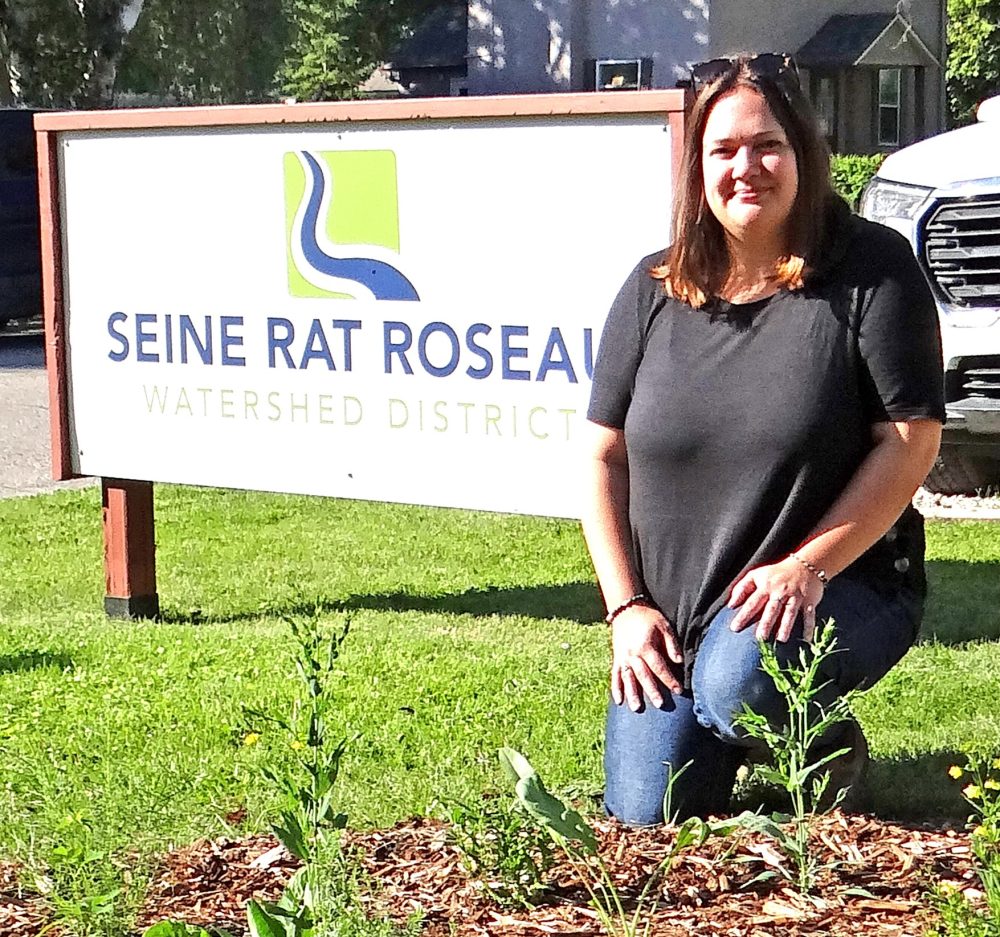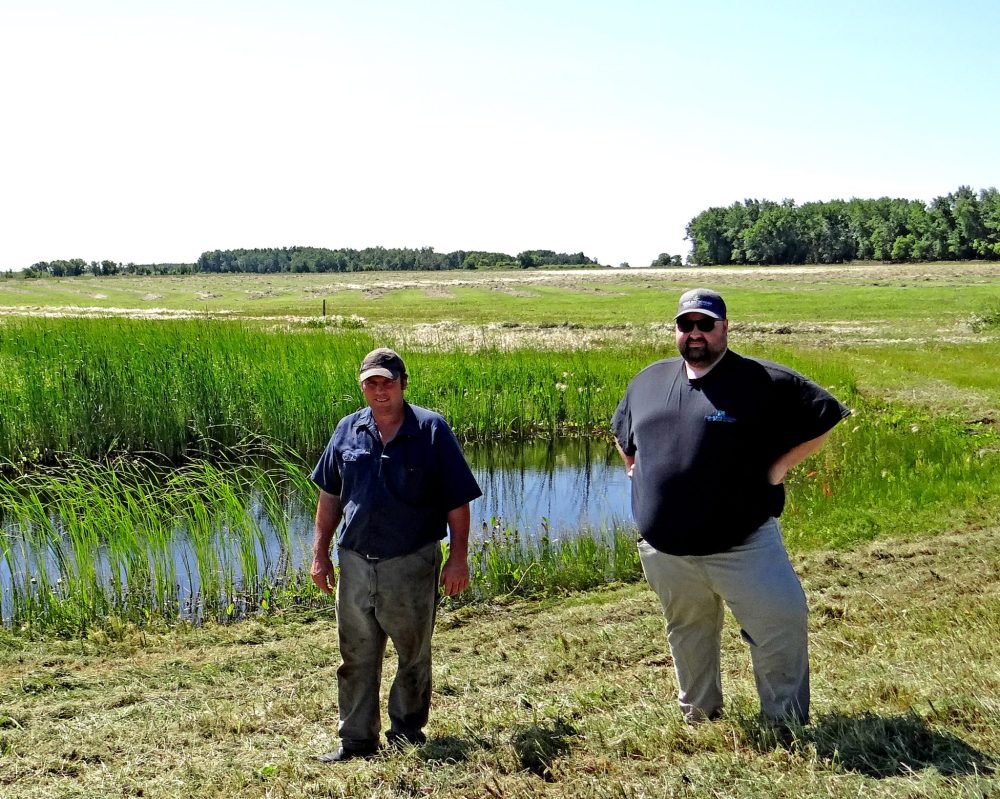Ridgeville farmer shows neighbours benefits of SRR Watershed projects
Advertisement
Hey there, time traveller!
This article was published 11/08/2024 (214 days ago), so information in it may no longer be current.
Last year’s winner of the Manitoba Watershed Association’s “District Builder Award” has never been averse to trying something new and has certainly taken a leadership role in a growing regenerative agriculture community in the Ridgeville area.
Seine Rat Roseau Watershed manager Joey Pankiw says Neil Claringbould was one of the first producers to sign up for the Alternative Land Use Services program in 2019, when he converted 40 acres of cultivated land into perennial grasses along a creek on his farm.
The next year, the Ridgeville farmer went back and added pollinators to the site, adding further environmental benefits.

Over the years, Claringbould has implemented several other ecological projects on the acres he farms in the Ridgeville area. He has fenced off riparian areas and dugouts to protect sensitive wetland areas, and created water retention ponds to help with water management in his area.
A sub-director on the SRRWD board since 2022, Claringbould is an enthusiastic promoter of all the projects that fall under the funding umbrella of the SRRWD, Pankiw says. Leading by example, Claringbould has impressed his neighbors to the point where enquiries about projects at the Watershed office often include the comment, “My neighbour Neil told me to contact you.”
In nominating Claringbould for the 2023 district award, the SRRWD said the Ridgeville farmer has a regenerative mindset and a willingness to listen that lends itself well to trying new things and redefining what it means to be a successful agriculture producer. He is always open to bringing the public to his farm to show how these projects are integrated into his operation.
During a tour of a couple of the projects on Claringbould’s farm last month, Neil explained how listening to the experts brought his family to Canada in 2,000 and a much more recent seminar impressed him with how regenerative farming made sense.
When Claringbould was a young man in Wales, his parents had a beef operation and he had a job with a company that sold and repaired farm equipment. He also helped his dad on the farm. One evening in 1999, “for something to do”, Claringbould attended a Canadian farm sales seminar in the area, conducted by Steinbach’s Bob Schinkel and Sheldon Froese.
Claringbould was impressed with the idea of farming in Canada. He says he couldn’t buy a farm in Wales because the land was too expensive there. It wasn’t long before he moved to Canada with his parents to a farm in Stuartburn. Today, he farms eight quarters in the Ridgeville area, with a 170-head cow/calf operation.
It was at another agriculture seminar that Claringbould heard of the benefits of regenerative farming practices, and changed the way he was farming.
What Ray Archuleta, a soil scientist with the United States Department of Agriculture and Gabe Braun, a North Dakota regenerative farmer, said had made sense to Claringbould.
The theme of the two experts was to adopt a farming practice built more on ecology and less on the reliance of chemical fertilizers and pesticides, using a variety of cover crops to regenerate the soil with a minimum of tilling.

Alternative Land Use Services projects are very much a part of the funding assistance provided by watershed districts throughout the province.
In the five years Pankiw has been with SRRWD, he says there has been a tremendous growth in government and industry support for projects aimed at the long-term sustainable use and management of land and water resources.
Since 2019, the SRRWD’s budget has increased from around $1 million to over $2.4 million. Funding comes from the province of Manitoba and 17 municipal partners in an integrated sharing plan. For every dollar the municipalities put in, the province matches with $3. Most of the SRRWD budget comes from external sources, including a number of agricultural industry sponsors and the federal government.
With the funding and the increased interest in the types of projects the Watershed District is supporting, more and more farmers across the SRRWD are taking the opportunity to participate in efforts to control overland flooding and provide cleaner water for livestock along the way.
Water retention projects like the ones on Claringbould’s farm provide an economic benefit for both farmer and municipality alike, Pankiw explains.
There are a number of projects on small creeks in the Ridgeville area. Dry dams hold back the water in times of heavy rain, slowing the flow by a couple days to up to a week.
This is a tremendous help to the municipality, as roads that used to wash out in a heavy rain no longer need that constant and costly maintenance, saving thousands of tax dollars.
The pond created by the construction of these dams provides a reservoir for the backflow and provides a water supply for grazing cattle.

The dugout has a culvert and the exact same design on two different creeks helps everybody downstream.
Fencing off creeks and dugouts keeps the cattle from wallowing and keeps feces out. Installation of an alternative, solar-powered watering system improves livestock health, as there is a much better weight-gain when the cattle are drinking clean water.
These projects are helpful to livestock health, the environment, the producers, and municipal governments alike, creating a win-win, win-win situation.
But the watershed doesn’t stop at the outskirts of urban settlements, Pankiw says, and there are watershed projects designed to curb pollution and deal with runoff problems in these communities as well.
Six or seven rain gardens are on the project schedule in the Seine Rat Roseau Watershed District this year, which includes more programming in urban areas.
Rain gardens, for example, are helpful in allowing the water to soak into the ground rather than running off in a heavy rain, carrying pollutants to ditches, streams and rivers and overwhelming a community’s storm sewer system.
In some areas, sump pumps are running all year, little areas where the water can soak in are most helpful. The Village of St Pierre has been having trouble with storm sewers backing up and is now providing funding for mulch for residents of the village who create rain gardens, Pankiw said. Funding for the rain garden projects comes from SRRWD, with the village providing the materials.
Dani Gosselin, Alternative Land Use Services co-ordinator for SRRWD, has been instrumental in creating a rain garden at the office in Steinbach to help educate the community on its benefits.

Sod was removed from an area of the front lawn, once the shape of the garden was determined. Soil was used to create a small berm on the down-slope side of the garden at 154 Friesen Avenue.
Gosselin said a variety of plants suitable for the climate conditions in this area were planted around the perimeter of the garden, which slopes to a bowl at its centre.
Water from eaves troughs is directed to the rain garden via a French drain rather than by surface drainage.
The variety of plants in the rain garden help to soak up the water. The SRRWD works with Prairie Shore Botanicals at Gardenton to get local plants and those that act as pollinators, Gosselin explains. Among the plants that do well in the Southeast are asters, milkweed, prairie loosestrife, and goldenrod.
Funding through the Seine Rat RoseauWatershed District office in Steinbach is available on a project by project basis, and in some cases as an annual acreage payment for Alternative Land Use; Agricultural Shelterbelt; Rain Garden; Surface Water Management and Prairie Water Climate Program projects.
